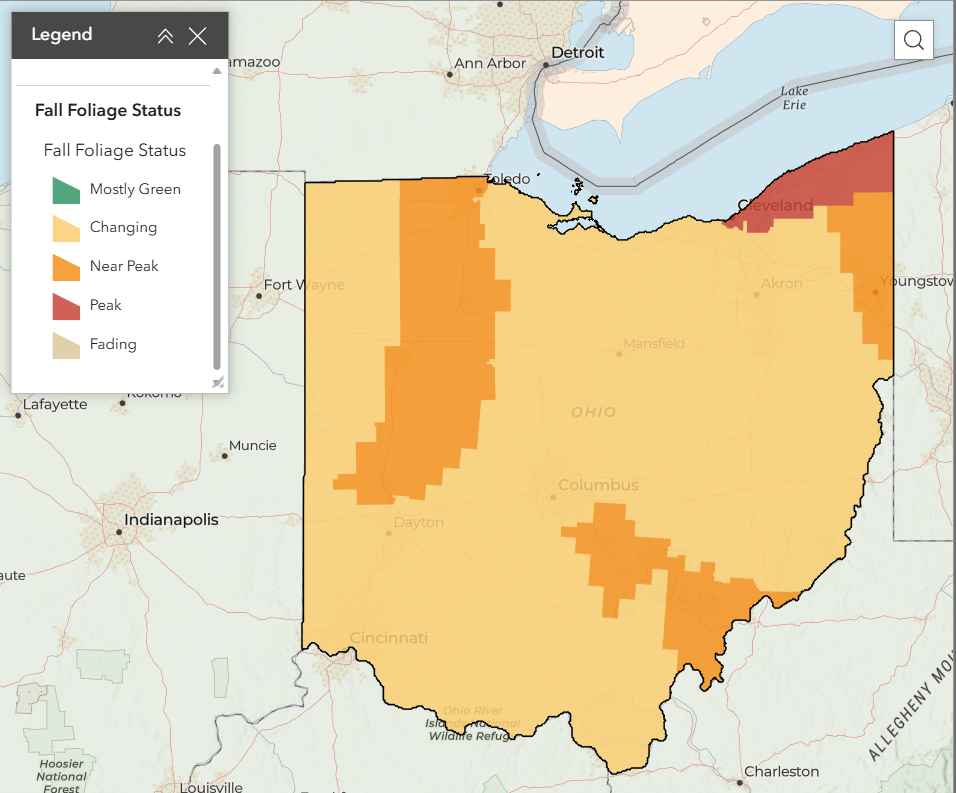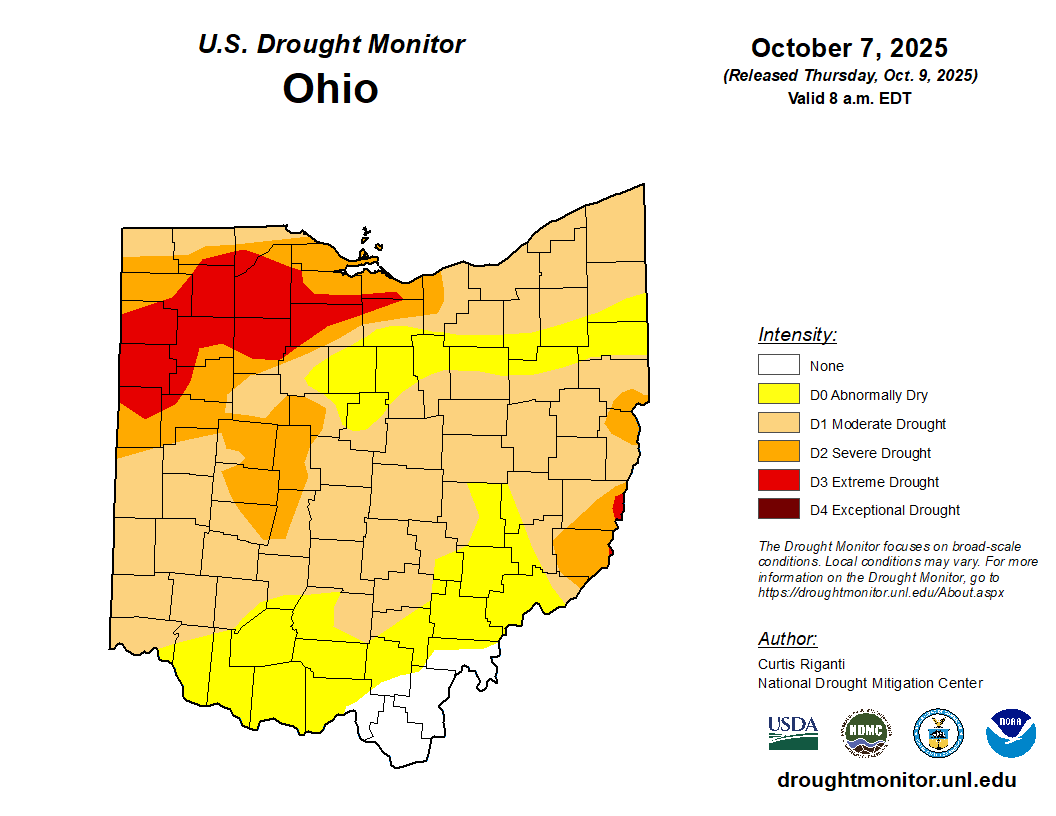Provided by the State Climate Office of Ohio, a collaboration of the Byrd Polar and Climate Research Center, Geography Department, and OSU Extension with support from Energent Solutions.
Subscribe to the Monthly Ohio Climate Summaries and Outlooks
Temperature
Ohio experienced above-average temperatures across much of the state this month. Statewide, mean temperatures generally ranged from 65–70 °F, with cooler values of 60–65 °F in northeast Ohio. A warmer pocket of temperatures ranged from 70–75 °F in the southernmost portion of the state (Fig. 1a). Compared to normal, most areas were 1–3 °F warmer, though pockets of near-normal temperatures extended across the northern half of the state, from west of Columbus through the northeast (Fig. 1b).

Product Note: All NCEI county-level data were not released due to the ongoing federal government shutdown. Because the monthly summaries rely on NCEI county-level temperature and precipitation rankings, these datasets will be excluded from the summaries until the data become available again.
Precipitation
Ohio experienced a clear north–south divide in precipitation this month. Southern Ohio recorded above-average totals, receiving between 3 to 8 inches of precipitation, while northern Ohio lagged behind with only 0.5 to 3 inches (Fig. 3a). Compared to normal conditions, the southern half of the state saw surpluses of 0.5 to 3.5 inches, whereas the north recorded deficits ranging from 0.5 to 3.5 inches below normal (Fig. 3b).

Product Note: All NCEI county-level data were not released due to the ongoing federal government shutdown. Because the monthly summaries rely on NCEI county-level temperature and precipitation rankings, these datasets will be excluded from the summaries until the data become available again.
Soil & Energy
At the end of September, soil moisture levels across Ohio reflected extremely dry conditions at both the 0 to 40 cm and 0 to 200 cm depths. At the shallower 0 to 40 cm layer, nearly all of northwest Ohio ranked in the 2nd percentile on the soil moisture scale, marking it as the driest region in the state. In contrast, southeast Ohio showed near-normal conditions, with values ranging from the 30th to 70th percentile (Fig. 5a). Deeper soil moisture (0 to 200 cm) displayed a similar pattern, with persistently dry soils in the northwest and more typical moisture levels in the southeast (Fig. 5b).

Product Note: Both NASA SPoRT LIS soil moisture products contain small pockets of inaccurate data indicating extremely wet or dry conditions. These small-scale errors can emerge in remote sensing products covering large areas or grid-spacings. For more information, please contact Geddy Davis (davis.5694@osu.edu).
Overall, Cooling Degree Days (CDDs) were above normal across the state in September, while Heating Degree Days (HDDs) averaged slightly below normal across the 10 climate divisions (Fig. 6). Consequently, due to warmer temperatures and above normal CDDs, energy demand for cooling increased, whereas the need for heating declined.

Notable Events
As October arrives, many of us are eager to see the stunning colors of fall foliage, but this year, those vibrant hues may be harder to find. Lingering drought conditions from late summer, combined with above-normal temperatures, are expected to dull the display. Because chlorophyll is breaking down earlier than usual, leaves are dropping faster and showing less color intensity. Warmer nighttime temperatures are also delaying the appearance of the bright yellows and reds we typically associate with peak season. While much of the region is still in the midst of leaf change or approaching peak color, northeast Ohio has already reached its peak (Fig. 7).

Drought
The U.S. Drought Monitor shows that 73.19% of Ohio is experiencing drought, affecting approximately 9.6 million people. While no areas are experiencing D4 (exceptional drought), a band of D3 (extreme drought) stretches across the northwest portion of the state. From there, a gradient of D2 (severe drought) and D1 (moderate drought) expands outward. In contrast, the southernmost regions are beginning to see relief, with dry conditions easing and no drought currently present (Fig. 8). However, the increase in D2 areas suggests that trees in those regions may shed their leaves earlier than usual. Although drier conditions are preferred for harvesting, the severity of the dryness is leading to reports of combine fires. These fires are initiated when the combines hit rocks that cause sparks. The use of combines in the fields right now is also stirring up dust, making visibility difficult when harvesting.

Looking Ahead
Even though fall often brings the promise of cooler weather and increased rainfall, the Climate Prediction Center is forecasting that the next three months are more likely to feature above-normal temperatures, with precipitation equally likely to be above or below average. Across most of Ohio, there is a 33–40% chance of experiencing above-normal temperatures, with probabilities climbing to 40–50% in the eastern part of the state (Fig. 9a). At the same time, precipitation outlooks remain uncertain, with equal chances of wetter or drier conditions across the entire state (Fig. 9b).

Warmer-than-normal temperatures this fall could delay the seasonal cool-down and prolong the impacts of Ohio’s ongoing drought. Better conclusion sentence. Given the equal chances of above or below-normal precipitation, drought conditions may persist, but opportunities for more impactful rainfall are not completely out of the question.
Note: these outlooks do not provide the quantity of above or below normal conditions, just the likelihood of occurrence (i.e., the probability).
Authors
Alexis Jahnke: Undergraduate Student, Student Assistant: Climate Services, Byrd Polar and Climate Research Center, The Ohio State University, jahnke.30@osu.edu
Aiden Ridgway: Undergraduate Student, Student Assistant: Climate Services, Byrd Polar and Climate Research Center, The Ohio State University, ridgway.72@osu.edu
Geddy R. Davis: Meteorologist/Atmospheric Scientist, Program Coordinator: Climate Services - Byrd Polar and Climate Research Center, The Ohio State University, davis.5694@osu.edu
Aaron B. Wilson: State Climate Office of Ohio, Byrd Polar and Climate Research Center & OSU Extension, The Ohio State University, wilson.1010@osu.edu
